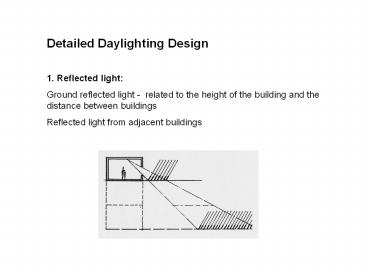Detailed Daylighting Design - PowerPoint PPT Presentation
1 / 16
Title:
Detailed Daylighting Design
Description:
Detailed Daylighting Design 1. Reflected light: Ground reflected light - related to the height of the building and the distance between buildings – PowerPoint PPT presentation
Number of Views:78
Avg rating:3.0/5.0
Title: Detailed Daylighting Design
1
Detailed Daylighting Design 1. Reflected light
Ground reflected light - related to the height
of the building and the distance between
buildings Reflected light from adjacent buildings
2
Detailed Daylighting Design 2. Shaped apertures
and sloped glazing Middle window location is not
optimal for distributing ground reflection nor
overcast sky. Overbite aperture is similar in
performance to overhangs and favours ground
reflected light. Greenhouse type apertures
favours light from the sky. Best for north
facing facades and overcast sky. Sloping sill
away from the building minimizes glare from the
sunlit sill and increases the collection of
ground-reflected light. Small windows may be
shaded by the depth of a thick wall.
3
Detailed Daylighting Design 3. Redirecting
devices Horizontal louvers can redirect the
light to the ceiling. Louvers with specular
finish must be above eyelevel to avoid glare.
Matt finished louvers diffuse the light in all
directions. Building scale louvers cause the
least interruption to view. One is in the
louver. These can also be combined with other
building elements and systems. Eg. Photo-voltaic
cells. At the other end of the spectrum, very
small scale louvers can be inconspicuous,
appearing as a screen or texture rather than a
competing pattern. These are more susceptible to
breakage. Overhangs may also be louvered.
However louvered overhangs will not function well
as light shelves.
4
Detailed Daylighting Design 4. Light shelves Can
be interior, exterior, or both. Hot climates
ext. lightshelf glazing shaded year
round. Temperate climates int/ext lightshelf
glazing shaded during cooling season. Temperate
climates alternative int. lightshelf optimizes
maintenance, control seasonal gain through lower
window. Cold climates glazing flush, all sun
admitted.
5
Detailed Daylighting Design 4. Light shelves
contd. Shaped aperture and lightshelf maximizes
winter gain and encloses HVAC to maximize ceiling
height, increases summer sun levels.
6
Detailed Daylighting Design 4. Lightshelves
contd. Lightshelves tend to limit additional
blinds to the lower window, ensuring clerestory
is kept unshaded. Best to leave a gap both on the
interior and exterior of the window to allow for
air movement at the window plane. In cold
climates, care must be taken to provide a thermal
break between the interior structure and the
structure supporting the lightshelf. Consider
maintenance at all times.
7
Detailed Daylighting Design 5. Glazing. Use the
appropriate glazing in the appropriate place.
Above the lightshelf use high visibility glazing
below, can use lower visibility glazing if glare
is a problem. Tinted glazing is the band-aid
solution to bad architectural design. It creates
a gloomy atmosphere. Clear glazing is the best
way to admit the amount of light desired.
8
Detailed Daylighting Design 6. Supplementary
shading devices Shutters Dark shutters
interfere with the view less, but reflect less
light. Shutters should be carefully integrated
into the framing of the window. Flared openings
on the inside improve light distribution
providing for a more comfortable visual
environment. Drapes can be opaque, filtering.
Offer sound absorption in hard surfaced rooms and
can soften an otherwise harsh environment. Make
sure there is space to store them so that they do
not block the light when they are open. Blinds
consider opening them from the bottom up. Opaque
and translucent sliding panels can increase
insulation at window openings.
9
Detailed Daylighting Design 8. Skylight
Design Terminology aperture, glazing material
(glass, acrylics, polycarbonates, fiberglass),
frame, curb, light well.
10
Detailed Daylighting Design 8. Skylight
Design Cut-off angle 55 degrees for computer
screens Sizes, shapes, layout. Ceilings should be
light coloured to reduce the contrast ratio. Does
the electric light supplement the skylight or
vice versa?
11
Daylighting Research Lighting design of
buildings is too often solely based on task
illuminance levels, with little consideration of
the importance of the light distribution for the
appearance and visual appeal of the lit
spaces. Daylighting research needs to focus on 2
areas 1. Proving that its use can reduce a
buildings energy consumption. 2. Proving that it
can significantly improve the lighting quality of
the indoor environment. It may also have health
benefits. How can we prove these points?
12
Daylighting Research 1. Develop reliable and
useable daylighting design tools Lighting
prediction tools Energy prediction tools User
oriented tools Life cycle cost simulation 2.
Design and conduct efficient daylighting
monitoring of buildings Develop international
protocols for the monitoring of real
buildings. Post Occupancy Evaluation
13
Daylighting Research 3. Predict daylight
availability Data collection and analysis
14
Daylighting Research 4. Advanced fenestration
systems Anidolic Ceiling Cylindrical Skylights
15
Daylighting Research 5. Daylight Responsive
Lighting Control Systems Dimmable fluorescent
lights Life cycle costing 6. Educate regarding
facility management and maintenance Develop
international protocols for the monitoring of
real buildings.
16
Daylighting Research 7. Accelerate market
penetration of daylighted buildings Professional
education and training Modify codes and
standards to encourage daylighting
solutions. Document and publicize successful
daylighted buildings.































